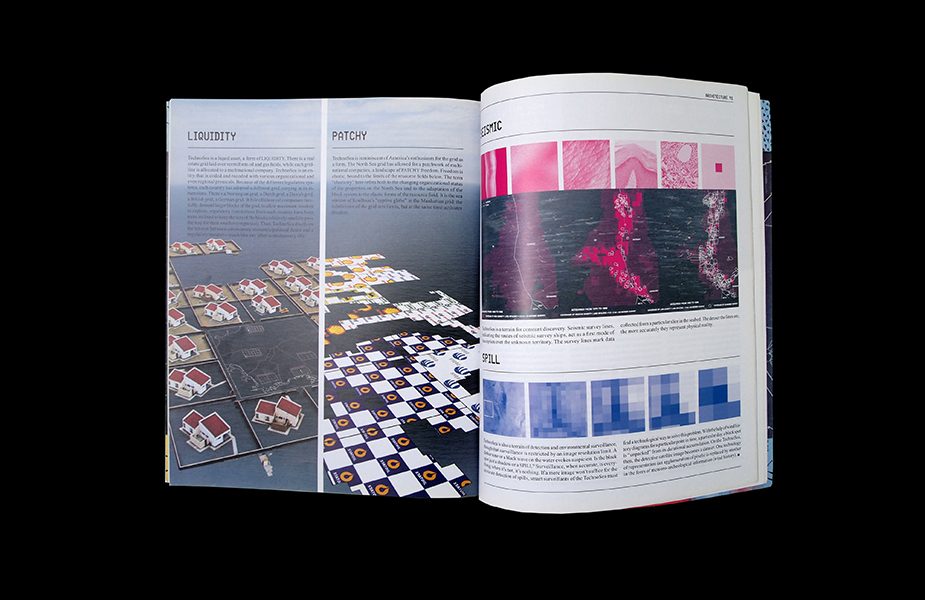BIG
TechnoSea is BIG. If the first provocative expression of the BIG in twentieth century architecture and urbanism is Le Corbusier's Aquitania collage, the Rem Koolhaas' skyscraper in Delirious New York would be the second. The skyscraper not only represented the "problem" of the large scale as related to architecture; it also pointed to the unconventional architectural expansion in embracing the absurdities of the private domain. As the problem of the large still haunts contemporary urban discussions and oscillates between the monumental (extra-fat buildings) and the organizational (networks, territories, and geographies), the image of a North Sea oil drilling rig standing beside a skyscraper seems ironic. The oil rig is a cyborg-monster that extends down to the organism of the sea. It is an ugly hybrid of the object and the network, a densely congested form fed by a city on the water. It is the ultimate icon of the TechnoSea.
PARADISE
TechnoSea is a PARADISE. It is a form of exclusion from the dominant system, a “free zone" where all laws are suspended but need to be recreated. If one could read, in the sea as in the landscape, the transformation of the architectural “techno-imagination" of the late twentieth century, one would clearly see the techno-utopian (Kurokawa, Floating Cities) mutating into the superfluous techno-visionary (Freedom Ship, a floating ship built on the scale of a mile-long city block of twenty five-story-tall buildings, or the extravagant man-made islands of contemporary Dubai). TechnoSea is a realization of an omnipotent, techno-political (not-yet- techno-visionary) imagination on the sea.
LEGITIMATE
TechnoSea is a liquid state territory. It is an enclosed entity, a terrain of resources molded by law, technology, and economy. If the 1960s dates to an essential shift in the history of resource landscapes, when the sea was conquered as a resource, it also marked the conquest of the oil and gas fields of the North Sea—a New Sea City as some named it then, or the TechnoSea. As a utopia and an alternative resource center, the TechnoSea would ostensibly reduce a dependence on Persian Gulf oil, particularly given the social and political unrest of the 1960s and 70s in the Middle East. In other words, urgency made the materialization of this particular form of technological utopia more rapid. But who, one might wonder, had the rights to the sea, and who could possibly demarcate LEGITIMATE boundaries on this vast, uncharted territory? Who was to decide what (a projected) legitimacy was? It was the United Nations, in the form of the first United Nations Convention on the Law of the Sea (Geneva, 1958). A Convention on the Continental Shelf gave each coastal state exclusive right over its continental shelf. With that, the TechnoSea had entered the realm of the legal.
LIQUIDITY
Technosea is a vast form of liquid asset, a form of LIQUIDITY. There is a real estate grid laid over vermiform oil and gas fields, while each gridline is allocated to a multinational company. TechnoSea is an entity that is coded and recoded with various organizational and even regional protocols. Because of the different legislative systems, each country has adopted a different grid, varying in its dimensions. There is a Norwegian Grid, a Dutch Grid, a Danish Grid, a British Grid, a German Grid. While offshore oil companies inevitably demand larger blocks of the grid, to allow maximum freedom to explore, regulatory committees from each country have been more inclined to keep the size of the blocks relatively smaller (to pave the way for their smaller companies). Thus, TechnoSea dwells on the tension between carnivorous economic/political desire and a regulatory instinct—much like any other contemporary city.
PATCHY
Technosea is reminiscent of the America's enthusiasm for the grid as a form. The North Sea grid has allowed for a patchwork of multinational companies, a landscape of PATCHY freedom. Freedom is elastic, bound to the limits of the vermiform resource fields below. The term "elasticity" here refers both to the changing organizational status of the properties on the North Sea and to the adaptation of the block system to the elastic forms of the resource field. It is the sea version of Koolhaas' Captive Globe in the Manhattan grid: the subdivision of the grid sets limits but at the same time activates freedom.
DISPERSION::CONGESTION
TechnoSea DISPERSES but in the end CONGESTS. Like every other city-territory, TechnoSea exposes not only larger organizational repertoires but also the particular design ethos of an era. The Ecofisk, the first giant oilfield of the TechnoSea, was also the first “town" to be erected. While the dominant design style was the old town pattern of the 1960s, in which different functions such as production, drilling and accommodation were segregated, the “new design pattern" of the 1990s was marked by the integration of all functions in one structure, as in the platform of Statjford, the largest oilfield on the TechnoSea. Like the congestion of a skyscraper, the Statjford oil rig accommodated various programs and architectural interventions in it: housing for about two thousand workers, sports centers, helicopter platforms and other technological production facilities.
SEISMIC& SPILL
TechnoSea is a terrain for constant discovery. Seismic survey lines, indicating the routes of seismic survey ships, act as a first mode of inscription over the unknown territory. The survey lines mark data collected from a particular slice in the seabed. The denser the more accurately they represent physical reality. TechnoSea is also a terrain of detection and environmental surveillance, though that surveillance is restricted by an image resolution limit. A darker tone or a black wave on the water evokes suspicion. Is the black spot a shadow or a SPILL? Nothing is certain on the TechnoSea grid before being validated by science and technology. Surveillance is everything but nothing without accuracy. If a mere image will not suffice for the accurate detection of spills, smart surveillants of the TechnoSea must find a technological way to solve this problem. With the help of wind history diagrams for a particular point in time, a particular day, a black spot is "unpacked" from its durational accumulation. On the TechnoSea, then, the detective satellite image becomes a dataset. One technology of representation (agglomeration of pixels) is replaced by another in the form of meteoro-archeological information (wind history).




